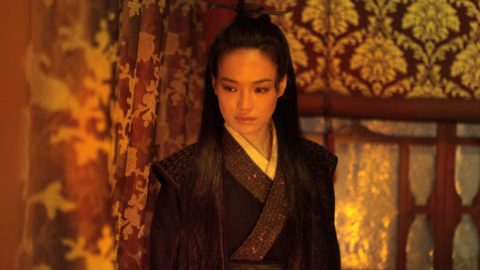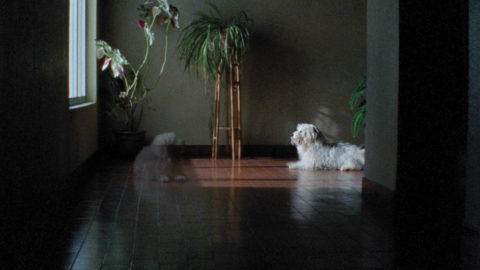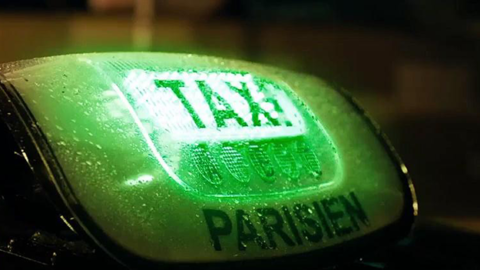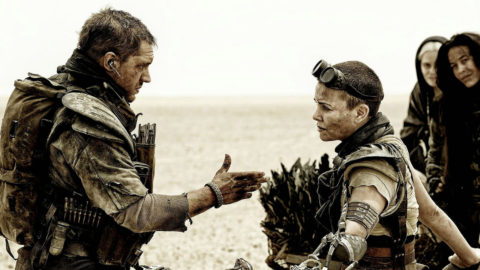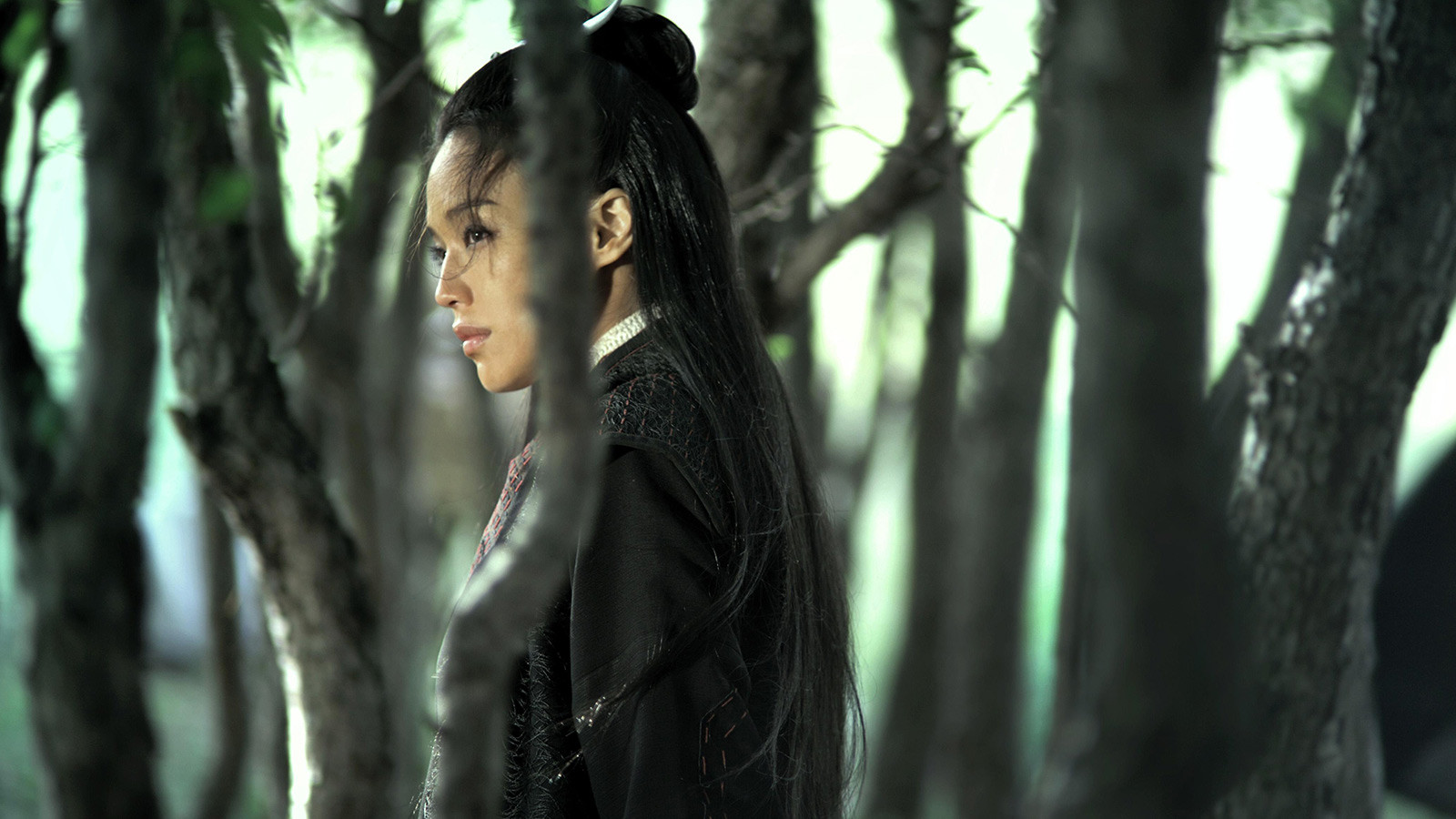
Setting Sun
In the eighth day of press screenings at Cannes 2015, a great film appeared. By then, many people, especially those in the industry, had gone home, suspecting that a lackluster selection would only get worse in the final four days. But Hou Hsiao-hsien’s The Assassin, crystalline in beauty and oblique in narrative, its titular heroine (Shu Qi) as taut and steely as her sword, reaffirmed one’s belief in movies, much as Hou’s 1998 Flowers of Shanghai had at the end of the last century.
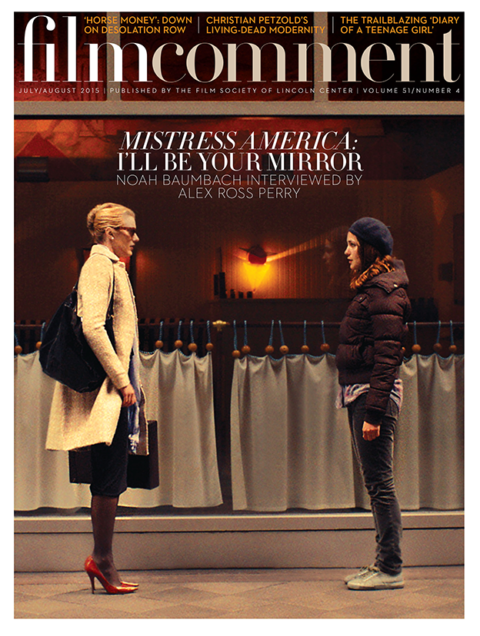
At the press conference, someone asked whether the assassin’s point of view dominates the film, to which Shu (through a translator) responded, “No more than the mountains or the forests.” Set in luxuriously rendered 7th-century China under the Tang Dynasty, The Assassin has contemporary resonances. The mountains endure; they exist out of time. So, too, a family of goats, lolling in the sun, chewing the cud. The assassin abandons her profession, and the deadly influence she wields over the political intrigues of the ruling class, to guide a nomadic goat-herding family to parts unknown. It might take a few viewings to sort out the elliptically composed plot, but Hou’s message is perfectly clear.

Son of Saul
The Assassin was shot on 35mm by Hou’s longtime cinematographer, Mark Lee Ping Bing, although it was projected as a DCP, as was every official entry in the festival except Son of Saul. Because of its shimmering surface, many people—including this writer—assumed it had been shot digitally, but the glitter was the result of a last-minute 2K transfer. Last year, in an interview in Paris a few days before his 3-D Goodbye to Language premiered at Cannes, Jean-Luc Godard remarked that he had been advised to master in 4K on the assumption that the higher the resolution and the newer the technology the better, but he preferred the older 2K because its “imperfections” functioned visually for him as a link to film. I have no idea what subtle imagistic changes there will be in The Assassin when it is released, but the fact that it was shot on film by a master matters very much.

Carol
Indeed, the only other movie in the festival in which images demanded and rewarded contemplation was Todd Haynes’s Carol, shot in Super 16 by Ed Lachman, in another long-standing pairing of director and cameraman. Adapted from Patricia Highsmith’s novel (originally published under a pseudonym and titled The Price of Salt) it is set in the early Fifties in New York (Cincinnati is not a convincing substitute location but that’s a minor matter). It concerns a lesbian, and therefore forbidden, love affair between Therese, a young, penniless photographer (Rooney Mara), and Carol, an upper-class suburban wife and mother (Cate Blanchett). Haynes charts the play of desire between them—the interchange and merging of subject and object—within a darkened mise en scène that makes the sudden illumination of a face literally breathtaking.

Nahid
Many were certain that the best Actress award would be split between Blanchett and Mara, but the choices of the Joel and Ethan Coen–led jury were nearly as quixotic as the Competition selection itself. Best Actress was indeed a split prize, but between Mara and Emmanuelle Bercot, with Blanchett left out in the cold. Bercot gives an absurdly overwrought performance as a woman obsessed with a lying, cheating drug addict (Vincent Cassel) in Maïwenn’s interminable soap opera Mon Roi. The actress also directed the tepid social drama Standing Tall, which played out of competition on opening night. Last year, the festival had its balls hung out to dry because so few films by women were included in the Competition. This year was no better—in fact, it was worse because neither of the female-directed films in the Official Selection could compare with 2014’s Grand Jury Prize winner, Alice Rohrwacher’s The Wonders. In addition to Mon Roi, the 2015 competition boasted Valérie Donzelli’s tasteful incest romance Marguerite & Julien and there was a special out-of-competition screening of Natalie Portman’s negligible directing debut, A Tale of Love and Darkness. It’s a toss-up as to whether it would have been better to have no films directed by women than any of these. Un Certain Regard, the second-tier section, however, showcased two such films that displayed more talent than half the films in the Competition regardless of the director’s gender. Despite some ridiculous plot details, Maryland leaves no doubt that its director and co-writer Alice Winocour has excellent action chops. And in Nahid, Ida Panahandeh brings fresh insight to the familiar subject of divorce Iranian style.

Mountains May Depart
If much of the festival felt like a slog, it began with a treat. One could have stayed home and seen George Miller’s Mad Max: Fury Road, but nowhere would it have looked better or felt more kinetic than in the Théâtre Lumière. Shooting digitally is no bar to kineticism, the other singular pleasure of the movies. Much later in the festival, Jia Zhang-ke’s Mountains May Depart blew us away from the get-go with a chorus line of 20-year-olds doing the Pet Shop Boys’ “Go West.” A glitch in the DCP at the press screening gave us the opportunity of seeing not once but twice Jia’s most exciting opening since the extended traveling shot of Zhao Tao running through backstage corridors in The World. An extremely ambitious albeit microcosmic depiction of China’s rapid transformation, the three-part film opens in 1999 with two young men courting the same young woman (Zhao, who would have gotten my vote for Best Actress). She chooses the rich guy over the poor miner, which turns out to be a bad decision because by 2014 (part two) her husband has divorced her and gained custody of their son. The miner is dying of lung disease so she would have been screwed either way. Indeed every character is screwed. The final section set in Australia 10 years in the future brings home all the ironies of the “Go West” opening.

Fatima
Though the selection of films by women left much to be desired, many of the best films had female protagonists, and actresses, in addition to Zhao, Shu, Blanchett, and Mara, rose to their respective occasions. Arnaud Desplechin’s intricate memory piece My Golden Days is not exactly a prequel to his My Sex Life… or How I Got Into an Argument but a re-envisioning of the filmmaker’s alter ego Paul Dedalus, in love and at crossed purposes. There’s recently been a glut of semi-autobiographical early memoirs by art-film directors, but this one is fascinating in its associative and psychologically rich plot turns and sequencing. It is, without doubt, a young man’s narrative, and Quentin Dolmaire’s Paul has the requisite charm and intelligence, but it’s Lou Roy-Lecollinet, whose intensity and emotional vibrancy makes an adolescent girl’s conflict—how her fear of being abandoned short-circuits her need for love—newly devastating; the film is much richer for her performance. Roy-Lecollinet is making her feature-film debut, as is Soria Zeroual in Philippe Faucon’s Fatima, a subtle, extremely compelling account of the relationship between a middle-aged Arab immigrant (Zeroual) and her French-assimilated daughters. Based on Prayer to the Moon, a collection of poems and short first-person prose pieces by Fatima Elayoubi, the film dramatizes the ways in which shame and pride define two generations of women. Taking possession of Elayoubi’s original texts and making us understand Fatima’s need to speak in her own voice, Zeroual brings a sense of exhilaration to what might otherwise have been a slight social drama.

Chronic
None of this is to detract from some first-rate performances by male actors. In Michel Franco’s unnecessarily mysterious Chronic, Tim Roth rises above the material, defining his character, a hospice nurse with a heavy burden of guilt, by making the subtext palpable at every moment. French favorite Vincent Lindon won the Best Actor award for playing a 60-year-old working-class bloke who’s laid off from a skilled factory job only to discover firsthand the abuses of capitalism, in Stéphane Brisé’s The Measure of a Man. Brisé’s film might have been no more than a variant on a Brechtian learning play (intelligently streamlined and didactic), but Lindon brings a vibrant reality of mind and body to every outrageous situation.

Amy
But by far the most mesmerizing screen presence and performance belonged to Amy Winehouse in Asif Kapadia’s superb documentary-biography Amy. The director of Senna, Kapadia again showed his tenacity in assembling huge amounts of footage of every kind—home video to professional concert recordings—and editing it to show not only a huge talent in action but also a determined, desiring, and, in this case, massively self-destructive addictive personality. A Jewish girl from North London who grabbed up the phrasing of Sarah Vaughn and the look of the Supremes, remaking them into something more audacious and moving than anyone would have thought a British twist on African-American jazz and pop could be in the 21st century, Winehouse burned through the Aughts and died of alcohol poisoning at age 27 in 2011. Like Senna, Amy is a ghost story, heartbreakingly rich with life.

Journey to the Shore
But then, cinema has always been a ghostly business. I didn’t do a count, but this year, every day brought at least one movie about death and mourning. The standout was Kiyoshi Kurosawa’s Journey to the Shore (a flat-footed title compared to the French translation Vers l’autre rive, “Toward the Other Side”). More matter-of-factly metaphoric than his trademark spooky psycho-horror films, Journey to the Shore is about a women whose husband has died at sea. Three years later, his extremely lively ghost returns to escort her on a trip to places they knew well as a way of helping her end her grieving. To carry on with an earlier theme, I think that cinema—art cinema—is going through an extended period of mourning for itself. This will not be apparent to viewers who have grown up with nothing but digital movies—digitally shot movies and digital copies of movies that originated on film. This year, the Cannes Classics section showed DCPs of supposed state-of-the-art restorations of such masterworks as Rocco and his Brothers, The Lady from Shanghai (part of a larger Orson Welles centennial tribute), Mizoguchi’s The Story of the Last Chrysanthemum and many others. I went to the Welles. It had become a ghost, a paper-thin scan of its former self. I couldn’t face seeing the others. Cannes Classics has been unbearable in this way for many years.

Hitchcock/Truffaut
Kent Jones’s documentary Hitchcock/Truffaut also showed in Cannes Classics. Intelligent and lively, it’s filled with memorable Hitchcock images and revelatory comments by David Fincher and James Gray in particular. But the movie also put me in mind of Godard’s passage in Histoire(s) du Cinéma (Chapter 4a) in which he says, in effect, that long after we’ve forgotten the whys and wherefores of the plots, we will remember “a handbag,” “a bus in the desert,” “a glass of milk”… Though Godard attributes the power of these images to Hitchcock’s placement of them within montage, he also asserts the phenomenal presence of Hitchcock’s photography in its own right. I venture that a person who has seen Marnie or North by Northwest or Suspicion only as a digital copy would not understand what Godard is talking about. And that loss is at the bottom of what some filmmakers and cinephiles were mourning at Cannes, knowingly or not.



